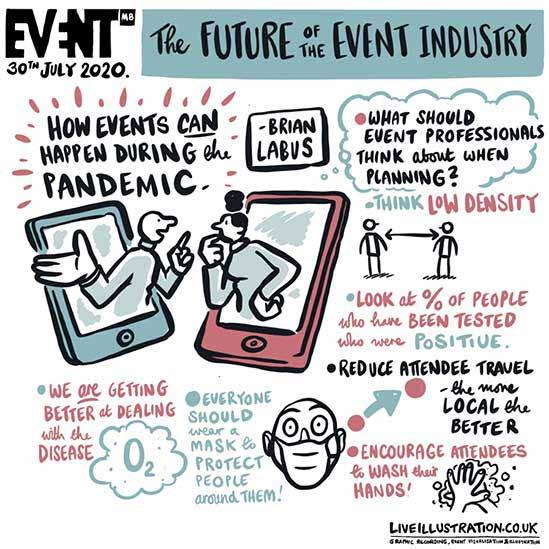
4 minute read
Who could ever have imagined that everything we knew about events a year ago would change so drastically? Meetings gets to the heart of what 2021 has in store.
The year 2020 has been one that will forever stand out in our minds – through the hardships of the impact of the Covid-19 pandemic have come many learnings, some of which have helped organisers to understand what really draws audiences into attending their events.
What has become increasingly evident as lockdown restrictions kept people apart is that connections – and connectivity – have become paramount to how we move forward through what is a challenging period for all. Beyond building business, through our shared experiences, particularly during this time, we have been able to establish much deeper
Advertisement
Elevated EXPERIENCES
connections with one another, and it’s all taking place in the form of meetings.
THE NEED TO UPSKILL Stats from a McKinsey report, which covered what business recovery will look like as a result of the adverse economic effects of Covid-19, noted that the first eight weeks of lockdown saw digital adoption within business and consumer industries quantum leap by five years. This skyrocketing growth and trend towards new technologies, to ensure that meetings and connections are made, mean we need to keep pace with the tech and upskill in the right areas.
HYBRID DIVERSITY Massive in-person conferences that run over consecutive days have, for now, been put on hold and it remains to be seen whether those numbers will ever be achievable again – at least in the short term.
According to data from the Professional Convention Management Association (PCMA) released during the last quarter of 2020, 76% of planners are taking their events virtual. Even prior to the pandemic, the push towards digital had already seen venues coming to the fore, with an assortment of innovative offerings to provide bespoke eventing solutions for their clients.
Social distancing and travel restrictions in the current context mean that in-person attendance for small numbers of locally based individuals is possible, while the success of your virtual attendance boils down to what your platform can support and the strength of your marketing efforts. This also underscores the need to have a refined strategy of who we target because volume, in this instance, doesn’t equate to market growth.
MERGING PLANNING AND MARKETING STRATEGIES Understanding your audience has never been so important. With time and money both being resources that would-be stakeholders are spending with increasing discernment, highlighting the value that your project or campaign can deliver on could possibly seal the deal on audience buy-in. Emphasising not-to-bemissed elements will ensure stronger uptake; however, all planning around this needs to be done with your target market in mind, while not losing sight of your business objectives.
Nowhere is the crossover between planning and marketing more evident than in a digital environment. From social media and email
shots, to registration and platform hosting, this is where the entirety of your project will take place – venue and all marketing collateral included. The beauty of this is that much can be done in-house, with polls and surveys helping to capture feedback before the moment passes, and with far more ease. This gives much deeper insights into how to improve and tailor experiences more closely to what audiences want.
THE VALUE OF CONNECTION The circumstances of working and operating in a digital world make for a fascinating showcase: while much of our face-to-face connections have disappeared, during 2020, we saw just how valuable those connections are, with more people being digitally connected than ever before.
Human connection forms the very basis of society and we are hardwired to seek this out; so much so that successful and complete social interactions trigger our biological reward system and release dopamine – a neurotransmitter chiefly responsible for how we experience pleasure.
While many yearn for in-person experiences, we are learning to find a way around these restrictions and enjoy social interaction differently, in a way that means we can still see and speak to each other in real time.
MOVE AUDIENCES One of the leading trends going into 2021 will be centred on empathy and the ability to connect with audiences on an emotional level. This means that our connections with each other are more authentic and relationships are strengthened because we are connecting as human beings.
Understanding audiences more holistically, rather than just in a business sense, will be the differentiator going forward; people want and need to connect in a meaningful way. Additionally, connecting with each other emotionally will create a deep, long-lasting and memorable impact. Memories steeped in emotion are often retained better: people tend to remember first how they felt, followed by finer details such as what they wore and the weather.
“Virtual events and event elements are limited in terms of their ability to engage
5WAYS TO KEEP AUDIENCES ENGAGED IN 2021
1Focus on the human element
2Create meaningful, purposeful experiences
3Allow participants to inform event formats
4Engage emotions over sensations
5Don’t neglect on-demand or post-event campaigning
all the senses – something planners are used to having at their disposal when it comes to designing experiences. But that doesn’t mean you can’t give attendees a memorable experience. The key is to engage them on an emotional level. Create content that resonates with your audience and relates to the challenges they face,” noted Event MB in a summary of The Future of the Event Industry virtual event, which was held at the end of July and attracted 10 000 registered attendees.







